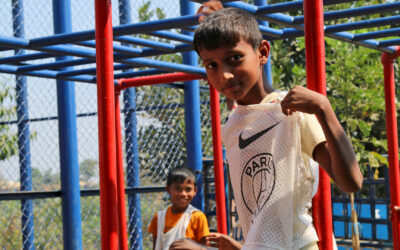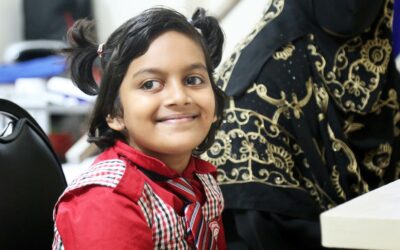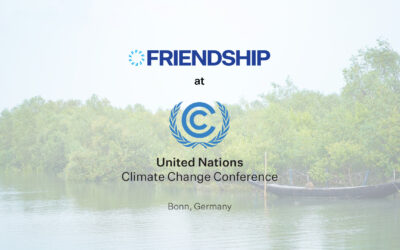‘Plinth’ settlements built on raised ground above the country’s flooding rivers are providing permanent homes and emergency refuges
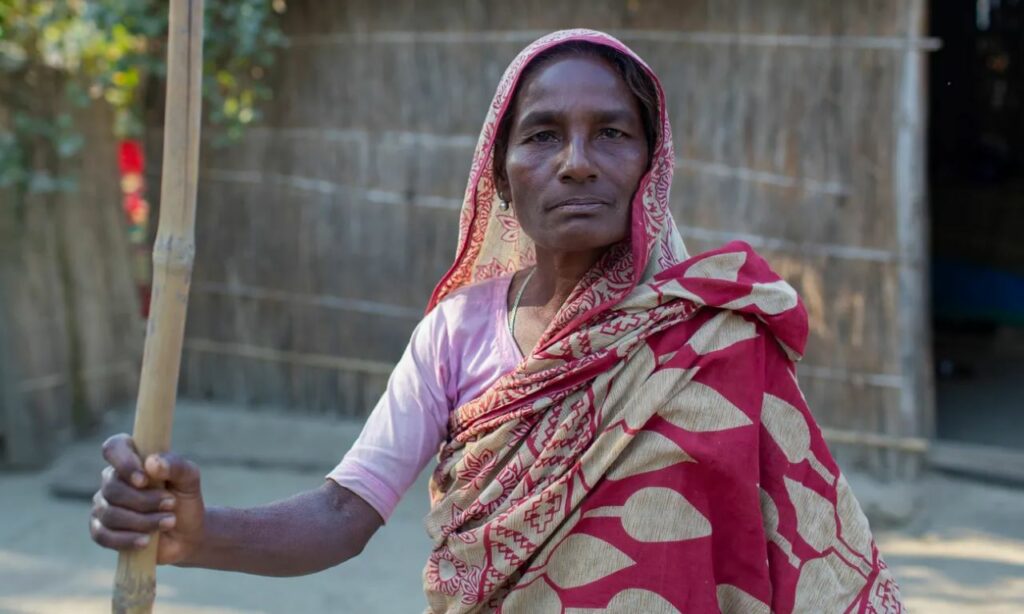
Thaslima Begum (The Guardian)
May 7, 2023
Hamida Khatun is sick of moving. The 60-year-old has been displaced about 20 times during her life, always as a result of climate disasters. “They seem to follow me wherever I go,” she says. But in 2019, the floods were the worst. “I thought at some point it would stop but it just kept rising and rising,” says Khatun. She saved herself from drowning by grabbing hold of a fallen banana tree that was floating past, and used it as a raft to get to safety.
Born in Tangail, central Bangladesh, Khatun moved from one makeshift home to another along the coastal belt before reaching Chilmari, a sub-district in the north, on the west bank of the Brahmaputra; one of the world’s largest rivers.
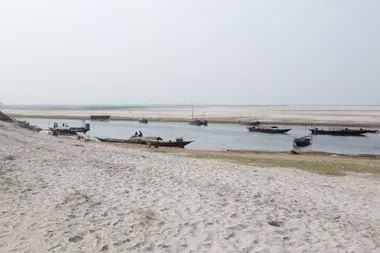
Once a vibrant port, Chilmari is now prone to catastrophic flooding. Every year thousands of hectares of land quietly crumble into the rivers that wind through it. Rushing waters constantly shift the landscape, breaking up the silty ground and turning it into a sea with thousands of tiny islands, known as chars.
Water can rise fast, by almost 12ft (3.6 metres), submerging houses on the river islands, and sinking vulnerable communities deeper into poverty. Erosion has long been a part of life here, devouring land and livelihoods. But it is getting worse. Water levels of all the major rivers in the country have been rising and last year, heavy monsoon rains led to the worst floods in Bangladesh in two decades.
In 2020, the charity Friendship carried out a study in Chilmari and found that 85% of displacement was down to riverbank erosion, 56% due to flooding and 3% due to storms. Since then, the displacement rate in the region further increased owing to the intensification and frequency of natural disasters.
Recent estimates suggest that by 2050, one in every seven people in Bangladesh will be displaced by climate change, and up to 18 million people may have to move because of sea level rises.
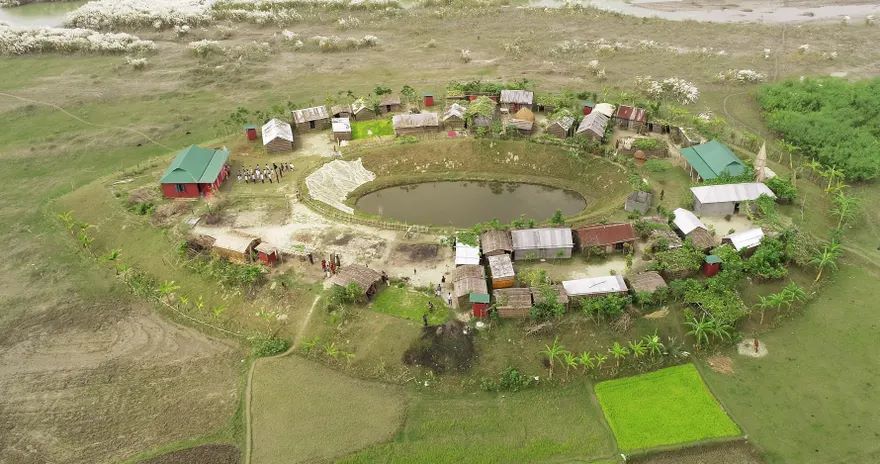
Friendship introduced a project of plinth housing – built on elevated land to create permanent safe housing as well as to accommodate displaced families and their possessions during floods. It’s a simple technique that has been used in flood-prone regions for millennia. Earth is dredged from rivers to create a large, oval-shaped plateau that is typically 8-10ft high, and strategically placed so that it can withstand the oncoming rush of water during monsoons. Each plinth can permanently accommodate 20-25 families and provide temporary shelter to up to 120 more in an emergency.
Early one morning, in a field in the village of Mudafat on Austamir char, a community consultation is taking place. The land has recently been acquired by Friendship and the construction of a new plinth will soon begin. A small group of villagers gather around Sahadat Hossain, a land surveyor involved in planning the project.
“The design of the plinth was initially based on a square but later changed to an oval shape that faces north. This is intended to allow water coming from the north to be diverted to either side of the oval,” says Hossain. “Over here, in the middle of the field, will be a freshwater pond, which will provide a source of drinking water and a place to fish.”
Plinth projects are not only carried out in consultation with the community but built by them, too. Villagers are employed throughout the construction period, enabling them to contribute towards the build and earn an income.
Friendship has built 20 plinths since 2011. Each costs about £40,000 to construct, if the charity is able to acquire free land. A local businessman, Mohammed Shahalom, 48, recently donated some of his family’s land for a new plinth to be built. “I’ve lived here all my life and it pains me to see my people struggle,” says Shahalom. “I decided to donate the land as sadaqa [charity] and I encourage others to do the same. There’s so much land here that is just not being utilised – and there is always goodness in giving.”
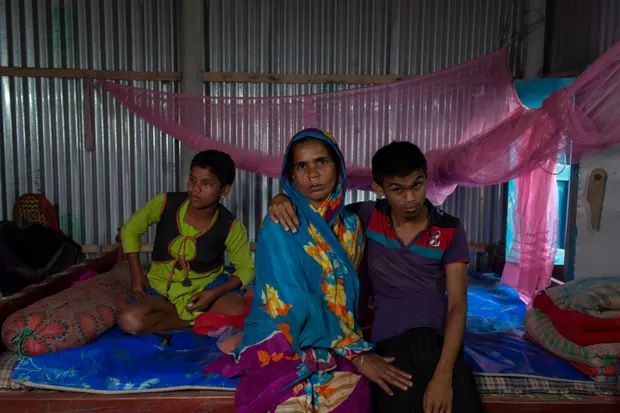
The list of those who will move to the new plinth is based on need. One of them is Khatun, who is looking forward to having a permanent home for the first time. “Moving to the plinth village will give me a peace of mind at last,” says Khatun. “I won’t have to worry about moving again and starting from scratch. I can finally think about my future and work towards it, knowing it won’t be snatched away so easily.”
On the waiting list is Musamat Rahima, 33, who was evicted from her last home for rent arrears. Rahima’s husband, a nut farmer, makes 3,000 taka a month (£22.50), not enough for their small family. Traditionally, the primary source of income for char dwellers has been agriculture, with nuts, corn, wheat, potato and various vegetables grown in the surrounding fields. But since extreme weather destroys the land and crops, many inhabitants now rely on government assistance.
Rahima joins her husband in the field when she can, though most of her day is spent taking care of their children, both of whom are disabled. “Life here is hard,” says Rahima. “Our destiny is determined by the water that surrounds us, which takes everything away. It drowns our livestock, kills our crops and leaves us without hope.”
During last year’s severe flooding, Rahima was out in the field when the water started to rise. She raced back to her small hut to find her children cowering neck deep in water. “They can’t swim and didn’t understand what was happening,” she says tearfully. “They must have been so scared. We were lucky they didn’t drown.” Rahima and her husband swam to safety, each carrying a child on their back.
The family is waiting to move to the new plinth.
“Moving to a safer environment will be better for us. Due to my children’s disabilities, I live in constant fear of what might happen to them,” says Rahima. “They keep getting sick. One currently has a waterborne skin infection. We get all their medication for free from the Friendship clinic; we couldn’t afford it otherwise.” As the main carer, Rahima’s capacity to work is limited.
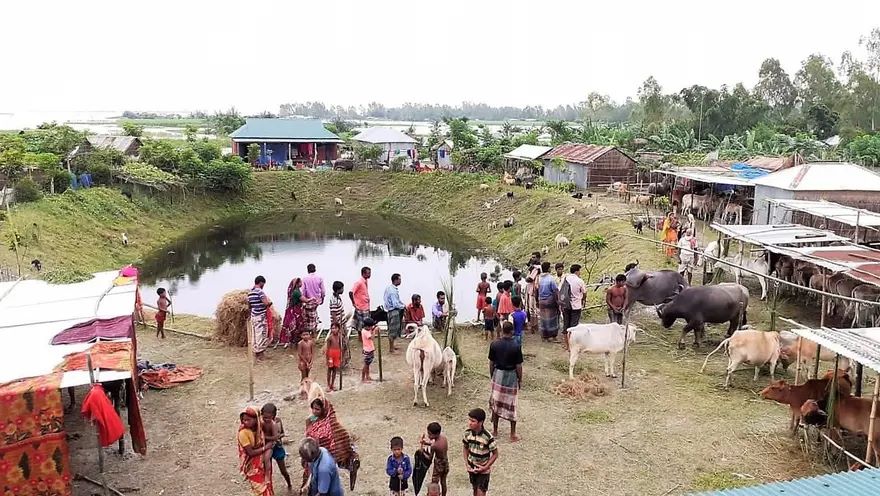
A recent UN report highlights how women’s lack of access to and control over basic resources makes them even more vulnerable to the impacts of climate change. “Climate impacts are not gender-neutral and affect women and girls more due to societal norms and gender inequalities,” says Maud Aba’a, a project officer at UN Women Bangladesh. “Restricted mobility, especially in the char areas, puts women in Bangladesh at higher risk during climate disasters and at a greater disadvantage. A long-term solution requires a more gender-centred approach.”
Friendship has set up disaster management committees and encourages women to join. “We can all work together to find better ways to keep the community safe,” says Sohrab Hossain, the chair of Austamir char. “Women need to be a part of key decision making as they are the most impacted.”
Several factors are taken into consideration for each plinth, including making space for a school. “Both the school and our home are solar powered, which means my daughter can study in the evenings and access resources,” says Shoneka Begum, 26, who moved to a plinth in Goynar Potol village, south of Chilmari in 2018.
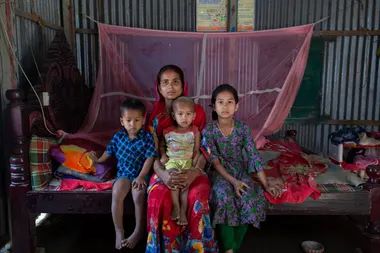
She is determined her three children should get a good education. “It is the only way out of this poverty,” says Begum. Her husband is a vegetable farmer earning 4,000 taka a month (£35), which pushes the couple towards taking loans to make ends meet, a common practice in the community, but microfinance company loans come with interest, often pushing people further into debt.
Begum lives in one of the bigger buildings on the plinth. Her home acts as a temporary shelter during emergencies. In 2020, extreme flooding in the village meant she had to take in approximately 50 people. “I don’t mind helping,” says Begum. “I know how tough it gets down there for families not yet living on a plinth – we all need to help where we can.”
For Begum, living on raised land means she fears her children might hurt themselves. “My son is only two and is constantly running off,” she says. “I’m always having to watch him in case he falls off.” But design features are being built in, for instance, the pond at the centre is barricaded to prevent children falling in and stoves are built away from the reach of young arms.
On the other side of the plinth lives Ibrahim Mollah. “It gets so exhausting moving from one place to another,” he says, sitting outside his home on a warm afternoon. At 80, Mollah finally feels a sense of stability. “I no longer have to worry about what will happen when the flood comes in. And it always does eventually.”

Mollah and his wife, Shurjo, have been displaced three times; each of three homes washed away during different floods. In 2015, the couple almost drowned.
“We were so scared. The water kept rising and I no longer had the energy to swim,” recalls Mollah. “My wife was holding on to one arm and I could feel her slipping away. I could see dead animals floating around us. I didn’t think we would make it that day.” They were rescued by a passing boat. “We spent the next few months living in a shared emergency shelter. It was very difficult.”
Mollah and Shurjo now take regular walks around the pond and can access a nearby medical clinic. “The plinths have been designed so thoughtfully,” says Mollah. “There are people and homes all around us, which makes us feel less isolated. It is more than just a raised hill, there is an intentional sense of community here.”
Note: This article was originally posted in The Guardian, on May 4, 2022. It can be read here.

